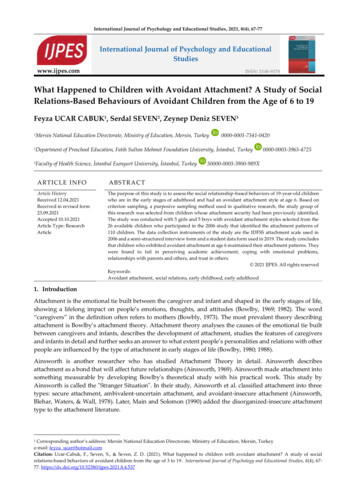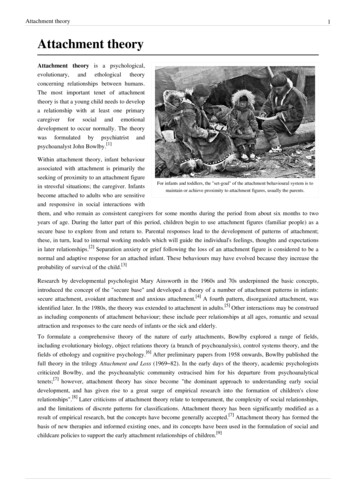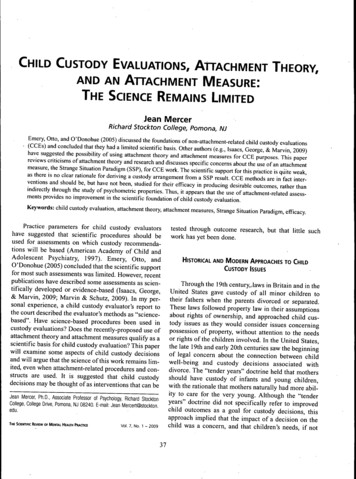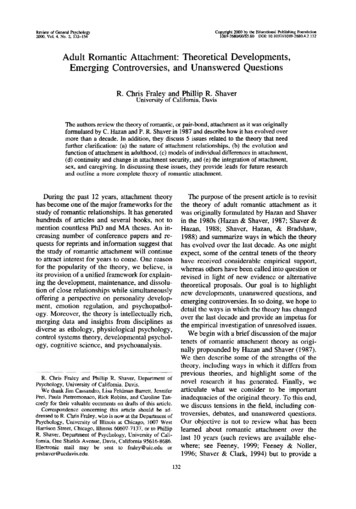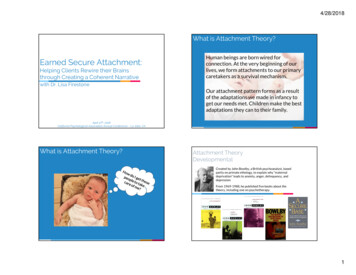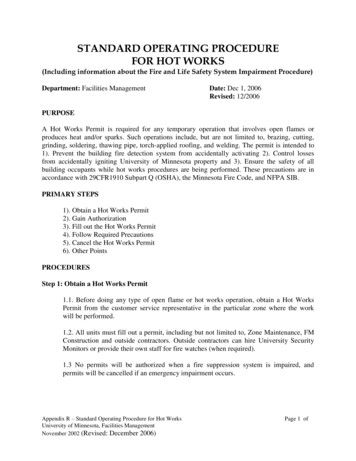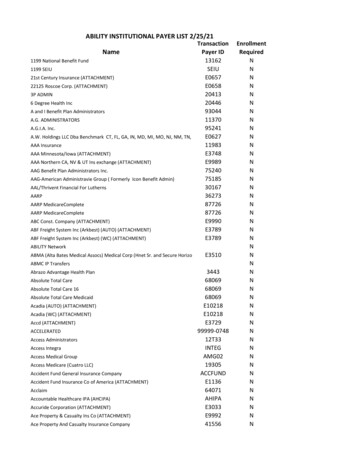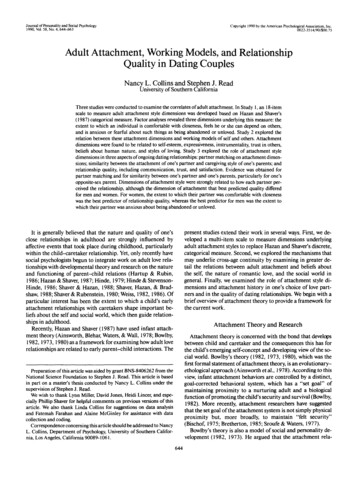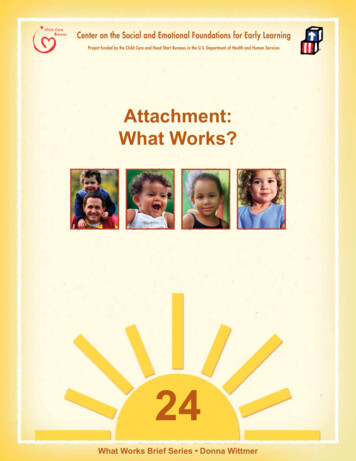
Transcription
Center on the Social and Emotional Foundations for Early LearningProject funded by the Child Care and Head Start Bureaus in the U.S. Department of Health and Human ServicesAttachment:What Works?24What Works Brief Series Donna Wittmer
MAttachment: What Works?arla, a 9-month-old, reached forher teacher when a parent andher infant entered the room.Her teacher held her and comfortedher. “You are wondering who thatperson is,” the teacher explained.“She’s Terrance’s mother. Let’s go sayhi to Terrance.” Marla, hanging onto her teacher’sneck, looked at Terrance and began to smile.After falling off a low bench, Devon, an 18-monthold, ran across the playground at top speed into thearms of his teacher. “Oh, did that scare you when youfell?”Asked his teacher. Devon nodded his head yes.“Do you want to sit on the bench together?” Devonnodded his head yes again.What is Attachment?Attachment refers to the continuing and lastingrelationships that young children form with one or moreadults. Attachment refers especially to one aspect of theadult-child relationship, the child’s sense of security andsafety when in the company of a particular adult. Theimportance of infants and toddlers experiencing secureattachment relationships with the key adults in their livesis well-known. In the examples above, both Marla andDevon feel secure and safe with their caregivers. Withintheir secure attachment relationships, they are learninghow to manage their strong emotions and reactions anddevelop their identity as persons who are competent atbeing in relationships.Infants and toddlers can have more than one secureattachment. Often, when professionals discussattachment, they refer to the parent-child relationship,but it is important that infants and toddlers who attendgroup care programs are securely attached to teachersas well. Infants and toddlers can feel secure within onerelationship while feeling insecure within another, butthey thrive when most or all of their relationships withthe adults in their lives are secure. When infants andtoddlers who attend group care programs experiencesecure attachments with their teacher(s), they can focusmore on learning, they are more affectionate with peers,and they have more empathy for both adults and peers.Why is Attachment Important?Attachment security makes a difference in youngchildren’s immediate and long-term behavior. Wheninfants and toddlers continually feel secure or insecurein their relationships, there are lasting effects, which caneven impact how they will parent when they are older.Children learn important lessons about how to interactwith other adults and peers in relationships. They learnhow to communicate effectively, how to negotiate andcooperate with others, and how others will treat them.Secure children play more harmoniously with their peersas they develop, and they score higher than insecurechildren on language and cognitive measures. Secureattachments also help children who have more fearful,inhibited temperaments become less fearful.Attachment influences how the brain is structured andhow many stress hormones young children experience.Infants and toddlers who consistently do not feel safemay begin to perceive adults and peers as threats andthe world as a dangerous place. They may expect othersto hurt them, so they react defensively. Children whoare securely attached to their teachers exhibit decreasedlevels of the stress hormone cortisol, while childrenwho are insecurely attached, especially those who havea more fearful temperament, exhibit increased levels ofcortisol throughout the day.Secure and Insecure AttachmentChildren’s behavior tells us whether they areexperiencing secure attachments or insecure attachments.Their actions tell us what they think about themselves,others, and relationships.Children with secure attachment relationships: Trust that their physical needs will be met by adults.This feeling of security allows children to focus onlearning new skills and building relationships withothers (adults and other children). Trust that adults will be emotionally available tothem. They learn that they can be intimate—closeand cherished—with another person and still be safe.They can explore their environment and return totheir special adults when they need a hug, a pat, orencouragement. Learn to communicate in a variety of ways.When adults respect, respond to, and engage withinfants’ attempts to communicate, the children’suse of language develops into more complex andsophisticated forms. Begin to manage (self-regulate) their strong reactionsand emotions with the help of adults. Adults canhelp children manage and express their emotions inhealthy ways and help them learn that strong feelingsare ok feelings.Children with insecure attachment relationships may: Behave as if they know that adults are inconsistentlyor seldom available. Stay close to an adult to get their needs met,inhibiting their exploration as a mobile infant ortoddler. Become distressed, but do not seek an adult to helpthem deal with their emotions. If adults are frequentlyangry with or intrusive toward young children, theymay initially avoid adults, but as they develop, theymay show anger and frustration with adults andpeers. Hide their strong feelings and withdraw to avoiddistressing events or to organize their emotions.When they withdraw, they miss opportunities to learnhow to handle distress or express feelings in a healthyway. Seem disorganized and confused about how tobehave in relationships.Issue 24 R www.vanderbilt.edu/csefel R Page 2
Cultural Differences in AttachmentIndividual children, and children from different culturesand family backgrounds, may show secure or insecureattachment differently. Adults should observe childrento see how they express whether they feel secure ornot, but recognize that in some cultures and families,feelings may not be expressed as openly as in othercultures. In addition, some cultures encourage theirchildren to be independent, so for these children, playingindependently may not mean that they are withdrawingfrom relationships. Teachers and Caregivers Make a Difference.The following are some strategies that teachers andcaregivers might use to promote children’s secureattachments. To support the parent-child relationship: Help parents feel competent and confident in theirparenting. Notice and describe when parents arewarm, responsive, and nurturing with their child. Helpparents to identify their own strengths as parents andto recognize when they are enjoying time with their child. In most cases, the ultimate goal should alwaysbe to strengthen the bond between parents and theirchildren. Provide extra support to parents when needed.Sometimes a child’s temperament, illness, behavior,or disability may be challenging for parents (andteachers) and they may need extra support to createstrong, positive child-family attachment relationships. Use home visits and individual time with the familyto provide resources and information to match theunique needs of the family.To foster a secure relationship with the child: Be warm, responsive, and affectionate with allchildren. Caregivers and teachers’ affection helpschildren feel worthwhile and teaches them how toshow affection. Reading and responding to cues givenby children is critical (e.g., smiling or reaching toindicate they want to interact, pulling away or archingtheir back to indicate they need a break from theinteraction, or showing sadness or distress). Engage in meaningful conversational interactionswith children. Reciprocity, taking turns ininteractions, helps young children feel competent. Be physically and emotionally available when amobile infant or toddler explores his/her environment.Mobile infants and toddlers explore their environmentand return to their special adults when they needa hug, a pat, or encouragement. Toddlers balancecloseness to an adult and exploration; they focus onaccomplishing tasks, yet will seek adult help whenthey need it. Comfort children when they are distressed. Infantsand toddlers learn to organize and manage theiremotions when adults consistently respond to theircommunication cues and comfort them when theyare distressed. When children feel insecure, stressed,or have experienced trauma, neglect, abuse, ormaltreatment, teachers and caregivers need to provideconsistent emotional support to help children feel safeand to help them trust adults again.Be an enthusiastic learning partner. When adultsare unintrusive, follow a child’s lead during play,and provide help that supports problem-solving, thechild’s confidence and motivation to learn grows.Share a child’s excitement about learning andremember that each moment during the day has thepotential for relationship building.Let children know that you will provide safe behaviorboundaries, keeping them, their peers, and their thingssafe. Adults who demonstrate and teach infants andtoddlers how to behave in a social way by example,rather than telling children what not to do, are notonly keeping children safe, but also teaching themhow to behave with others. For example, showing achild how to touch a peer gently instead of simplytelling them to stop demonstrates the suitablebehavior.Provide small groups, low adult-child ratios, andprimary care. An environment that allows forconsistency in personnel, substantial time, andadequate space to build 1:1 relationships is a keyingredient in forming strong, healthy attachmentsbetween children and adults.Move caregivers and teachers with a group of childrento a new room as children develop. Consistency iscritical for infants and toddlers as they transition tonew environments. Allowing for a way to let adultsmove with some of the children to a new environment(infant care to a toddler classroom) will help childrenfeel secure as they face changes and new challengesin the environment.Develop program policies to refer families who needadditional mental health support to the right resources.Families who experience stress need ongoing socialsupport, so that they can be warm, responsive, andaffectionate with their children. Programs can help byproviding families information and access to materialsand other resources. Programs can also serve as abridge between families and services available in theircommunities.Who are the children and families who haveparticipated in research on attachment?Researchers have studied attachment for approximately50 years. Typically developing children, and childrenwith disabilities, including children from low- andmiddle-income families, have been observed with theirmothers, fathers, and teachers. Children from a varietyof cultures have been observed to determine culturaldifferences in attachment to their parents. RResources for ParentsBrazelton, T.B., & Sparrow, J.D. (2006). Touchpoints.Birth to 3: Your child’s emotional and behavioraldevelopment (2nd ed.). New York: Da Capo Press.Goleman, D. (2006). Emotional intelligence: Why it canmatter more than IQ (10th anniversary edition). NewYork: Bantam.Lerner, C., & Dombro, A.L. (2006). What’s best for mybaby and me: A three-step guide for parents.Washington, DC:Zero to Three.Issue 24 R www.vanderbilt.edu/csefel R Page 3
Center on the Social and Emotional Foundations for Early LearningWe welcome your feedback on this What Works Brief. Please go to the CSEFEL Web site(http://www.vanderbilt.edu/csefel) or call us at (866) 433-1966 to offer suggestions.Where do I Find More Information on Attachment?See the CSEFEL Web site (http://www.vanderbilt.edu/CSEFEL) for additional resources. There are many books,articles, manuals, and pamphlets available that describe the use of this strategy. These include:Honig, A.S. (2002). Secure relationships. Nurturing infant/toddler attachment in early care setting. Washington, D.C.:NAEYC.Karen, R (1998). Becoming attached: First relationships and how they shape our capacity to love. England: OxfordUniversity Press.Lally, R.J., Mangione, P.L., & Greenwald, D. (2006). Concepts for care. Sausalito, Ca: WestEd.Rutter, M. (2008). Implications of attachment theory and research for child care policies. In J. Cassidy, & P.R. Shaver(Eds.), Handbook of attachment: Theory, research and clinical applications (2nd ed., pp. 958–974). New York:Guilford Press.Thompson, R.A. (2000). The legacy of early attachments. Child Development, 71(1), 145-152.What is the Scientific Evidence on the Importance of Secure Attachments?For those wishing to explore this topic further, the following resources may prove valuable.Belsky, J. & Fearon, R.M.P. (2002). Early attachment security, subsequent maternal sensitivity, and later childdevelopment: Does continuity in development depend upon continuity of caregiving? Attachment and HumanDevelopment, 4, 361-387.Carter, A. S., Garrity-Rokous, F.E., Chazan-Cohen, R., Little, C., & Briggs-Gowan, M.J. (2001). Maternal depressionand comorbidity: Predicting early parenting, attachment security, and toddler social-emotional problems andcompetencies. Journal of the American Academy of Child and Adolescent Psychiatry, 40 (1), 18-26.Cassidy, J., & Shaver, P.R. (2008). Handbook of attachment: Theory, research and clinical applications (2nd ed.).New York: Guilford Press.Donovan, W., Leavitt, L., Taylor, N., & Broder, J. (2007). Maternal sensory sensitivity, mother–infant 9-monthinteraction, infant attachment status: Predictors of mother–toddler interaction at 24 months. Infant Behavior &Development, 30 (2), 336-352.Dozier, M., & Rutter, M. (2008). Challenges to the development of attachment relationships faced by young childrenin foster and adoptive care. In J. Cassidy, & P.R. Shaver, (Eds), Handbook of attachment: Theory, research andclinical applications (2nd ed., pp. 698–717). New York: Guilford Press.Mills-Koonce, W. R., W., Jean-Louis, G., Propper, C., Sutton, K., Calkins, S., Moore, G., Cox, M. (2007). Infant andparent factors associated with early maternal sensitivity: A caregiver-attachment systems approach. InfantBehavior & Development, 30 (1) 114-126.This What Works Brief is part of a continuing series of short, easy-to-read, “how to” information packets on a variety of evidence-based practices,strategies, and intervention procedures. The Briefs are designed to help teachers and other caregivers support young children’s social and emotionaldevelopment. In-service providers and others who conduct staff development activities should find them especially useful in sharing information withprofessionals and parents. The Briefs include examples and vignettes that illustrate how practical strategies might be used in a variety of early childhood settings and home environments.This material was developed by the Center on the Social and Emotional Foundations for Early Learning with federal funds from the U.S. Departmentof Health and Human Services, Administration for Children and Families (Cooperative Agreement N. PHS 90YD0215). The contents of this publicationdo not necessarily reflect the views or policies of the U.S. Department of Health and Human Services, nor does mention of trade names, commercialprojects, or organizations imply endorsement by the U.S. Government. You may reproduce this material for training and information purposes.Newsletter constructed by the Graphics Core of the Vanderbilt Kennedy Center, Vanderbilt University. kc.vanderbilt.eduIssue 24 R www.vanderbilt.edu/csefel R Page 4
AttachmentR Ensuring that infants and toddlers have strong attachmentsand safe, affectionate, and enduring relationships withfamily members and teachers is important because:HANDOUT 24 Children learn important lessons about themselves and others from their attachmentrelationship experiences. Infants and toddlers who feel securely attached (safe and protected) with theircaregivers are able to interact more positively with adults and peers and focus on learning. Mobile infants and toddlers feel safe to explore their environment when they feel securely attached to theircaregivers. Infants and toddlers learn to organize and manage their emotions when adults are consistently responsive to theircommunication cues and comfort them when they are distressed. Infants and toddlers who do not feel safe within warm relationships may begin to perceive adults and peers asthreats and the world as a dangerous place.Remember: Infants and toddlers develop secure attachments with special caregivers (family members and teachers) overtime because of responsive, affectionate, emotionally available interactions. Infants and toddlers can be securely attached to more than one person. Secure attachments to both familymembers and teachers provide children with emotional support, build children’s sense of self-worth, and helpthem value relationships. Families who experience stress need ongoing social support, so that parents can be warm, responsive, andaffectionate with their children. When caregivers are inconsistent in their responses, infants and toddlers may become more dependent on theircaregivers in order to be protected. Alternately, when caregivers are frequently angry with children, children maylearn to avoid adults, but may become angry with adults and peers because their emotional needs are not met. Secure attachments become insecure attachments when caregivers become less responsive. Insecure attachmentscan become secure when caregivers become more responsive and affectionate.This material was developed by the Center on the Social and Emotional Foundations for Early Learning with federal funds from the U.S. Departmentof Health and Human Services, Administration for Children and Families (Cooperative Agreement N. PHS 90YD0215). The contents of this publicationdo not necessarily reflect the views or policies of the U.S. Department of Health and Human Services, nor does mention of trade names, commercialprojects, or organizations imply endorsement by the U.S. Government. You may reproduce this material for training and information purposes.Newsletter constructed by the Graphics Core of the Vanderbilt Kennedy Center, Vanderbilt University. kc.vanderbilt.eduIssue 24 R www.vanderbilt.edu/csefel R February 2011
AttachmentR Ensuring that infants and toddlers have strong attachmentsand safe, affectionate, and enduring relationships withfamily members and teachers is important because:HANDOUT 24 Children learn important lessons about themselves and others from their attachmentrelationship experiences. Infants and toddlers who feel securely attached (safe and protected) with theircaregivers are able to interact more positively with adults and peers and focus on learning. Mobile infants and toddlers feel safe to explore their environment when they feel securely attached to theircaregivers. Infants and toddlers learn to organize and manage their emotions when adults are consistently responsive to theircommunication cues and comfort them when they are distressed. Infants and toddlers who do not feel safe within warm relationships may begin to perceive adults and peers asthreats and the world as a dangerous place.Remember: Infants and toddlers develop secure attachments with special caregivers (family members and teachers) overtime because of responsive, affectionate, emotionally available interactions. Infants and toddlers can be securely attached to more than one person. Secure attachments to both familymembers and teachers provide children with emotional support, build children’s sense of self-worth, and helpthem value relationships. Families who experience stress need ongoing social support, so that parents can be warm, responsive, andaffectionate with their children. When caregivers are inconsistent in their responses, infants and toddlers may become more dependent on theircaregivers in order to be protected. Alternately, when caregivers are frequently angry with children, children maylearn to avoid adults, but may become angry with adults and peers because their emotional needs are not met. Secure attachments become insecure attachments when caregivers become less responsive. Insecure attachmentscan become secure when caregivers become more responsive and affectionate.This material was developed by the Center on the Social and Emotional Foundations for Early Learning with federal funds from the U.S. Departmentof Health and Human Services, Administration for Children and Families (Cooperative Agreement N. PHS 90YD0215). The contents of this publicationdo not necessarily reflect the views or policies of the U.S. Department of Health and Human Services, nor does mention of trade names, commercialprojects, or organizations imply endorsement by the U.S. Government. You may reproduce this material for training and information purposes.Newsletter constructed by the Graphics Core of the Vanderbilt Kennedy Center, Vanderbilt University. kc.vanderbilt.eduIssue 24 R www.vanderbilt.edu/csefel R February 2011
Secure and Insecure Attachment Children's behavior tells us whether they are experiencing secure attachments or insecure attachments. Their actions tell us what they think about themselves, others, and relationships. Children with secure attachment relationships: Trust that their physical needs will be met by adults.
